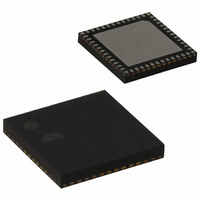EM357-RTR Ember, EM357-RTR Datasheet - Page 35

EM357-RTR
Manufacturer Part Number
EM357-RTR
Description
IC RF TXRX ZIGBEE 192KB 48QFN
Manufacturer
Ember
Specifications of EM357-RTR
Frequency
2.4GHz
Data Rate - Maximum
250kbps
Modulation Or Protocol
802.15.4 Zigbee
Applications
General Purpose
Power - Output
5dBm
Sensitivity
-100dBm
Voltage - Supply
2.1 V ~ 3.6 V
Current - Receiving
26mA
Current - Transmitting
31mA
Data Interface
PCB, Surface Mount
Memory Size
192kB Flash, 12kB RAM
Antenna Connector
PCB, Surface Mount
Operating Temperature
-40°C ~ 85°C
Package / Case
48-QFN
Lead Free Status / RoHS Status
Lead free / RoHS Compliant
Other names
636-1011-2
Available stocks
Company
Part Number
Manufacturer
Quantity
Price
Company:
Part Number:
EM357-RTR
Manufacturer:
SILICON
Quantity:
3 000
Part Number:
EM357-RTR
Manufacturer:
SILICON
Quantity:
20 000
1
2
Table 5-2 shows the mapping of the option bytes that are used for read and write protection of the flash. Each
bit of the flash write protection option bytes protects a 4 page region of the main flash block. The EM351 has
16 regions and therefore option bytes 4 and 5 control flash write protection (option byte 6 is
reserved/unused). The EM357 has 24 regions and therefore option bytes 4, 5, and 6 control flash write
protection. These write protection bits are active low, and therefore the erased state of 0xFF disables write
protection. Like read protection, write protection only takes effect after a reset. Write protection not only
prevents a write to the region, but also prevents page erasure.
Option byte 0 controls flash read protection. When option byte 0 is set to 0xA5, read protection is disabled.
All other values, including the erased state 0xFF, enable read protection when coming out of reset. The
internal state of read protection (active versus disabled) can only be changed by applying a full chip reset. If a
debugger is connected to the EM35x, the intrusion state is latched. Read protection is combined with this
latched intrusion signal. When both read protection and intrusion are set, all flash is disconnected from the
internal bus. As a side effect, the CPU cannot execute code since all flash is disconnected from the bus. This
functionality prevents a debug tool from being able to read the contents of any flash. The only means of
clearing the intrusion signal is to disconnect the debugger and reset the entire chip using the nRESET pin. By
requiring a chip reset, a debugger cannot install or execute malicious code that could allow the contents of
the flash to be read.
The only way to disable read protection is to program option byte 0 with the value 0xA5. Option byte 0 must
be erased before it can be programmed. Erasing option byte 0 while read protection is active automatically
mass-erases the main flash block. By automatically erasing main flash, a debugger cannot disable read
protection and readout the contents of main flash without destroying its contents.
Note: When read protection is active, the bottom four flash pages, addresses 0x08000000 to 0x08001FFF, are
automatically write-protected. Write protecting the bottom four flash pages of main flash prevents an
attacker from reprogramming the reset vector and executing arbitrary code.
In general, if read protection is active then write protection should also be active. This prevents an attacker
from reprogramming flash with malicious code that could readout the flash after the debugger is
disconnected. Even though read protection automatically protects the reset vector, the same technique of
reprogramming flash could be performed at an address outside the bottom four flash pages. To obtain fully
protected flash, both read protection and write protection should be active.
Address
0x08040800
0x08040802
0x08040804
0x08040806
0x08040808
0x0804080A
0x0804080C
0x0804080E
are best used for storing data that requires a hardware verification of the data integrity.
Option bytes 2 and 3 do not link to any specific hardware functionality other than the option byte loader. Therefore, they
Option byte 6 is reserved/unused in the EM351 due to the smaller flash size.
Inverse Option Byte 0
Inverse Option Byte 1
Inverse Option Byte 2
Inverse Option Byte 3
Inverse Option Byte 4
Inverse Option Byte 5
Inverse Option Byte 6
Inverse Option Byte 7
bits [15:8]
Table 5-1. Option Byte Storage
Final
5-5
bits [7:0]
Option Byte 0
Option Byte 1
Option Byte 2
Option Byte 3
Option Byte 4
Option byte 5
Option Byte 6
Option Byte 7
Notes
Configures flash read protection
Reserved
Available for customer use
Available for customer use
Configures flash write protection
Configures flash write protection
Configures flash write protection
Reserved
EM351 / EM357
120-035X-000G
1
1
2



















